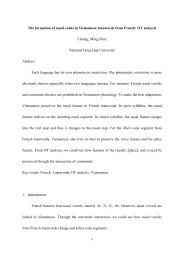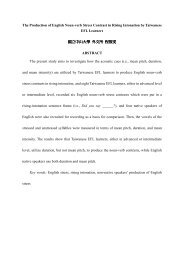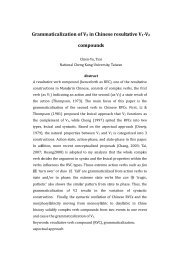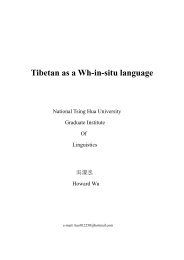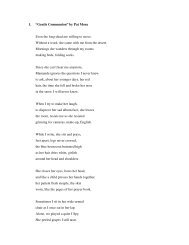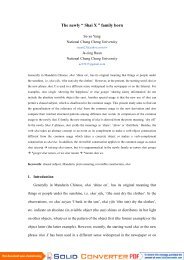The Production of English Noun-Verb Stress Contrast in Rising ...
The Production of English Noun-Verb Stress Contrast in Rising ...
The Production of English Noun-Verb Stress Contrast in Rising ...
Create successful ePaper yourself
Turn your PDF publications into a flip-book with our unique Google optimized e-Paper software.
<strong>The</strong> <strong>Production</strong> <strong>of</strong> <strong>English</strong> <strong>Noun</strong>-<strong>Verb</strong> <strong>Stress</strong> <strong>Contrast</strong> <strong>in</strong> Ris<strong>in</strong>g Intonation byTaiwanese EFL LearnersThis paper <strong>in</strong>vestigates the phonetic characteristics <strong>of</strong> the <strong>English</strong> noun-verb stresscontrast (i.e., pérmit (n.) vs. permít (v)) produced by Taiwanese EFL learners. Previousstudies have shown that L2 learners whose L1 does not have lexical stress have problems <strong>in</strong>produc<strong>in</strong>g <strong>English</strong> stress to some extent. For <strong>in</strong>stance, Kondo (2009) reports that L1 Japanesespeakers tend to use higher pitch, longer duration and greater <strong>in</strong>tensity <strong>in</strong> produc<strong>in</strong>g <strong>English</strong>stressed syllable but they fail to cue stress us<strong>in</strong>g vowel quality. Furthermore, Lai (2008)reports that L1 Mandar<strong>in</strong> speakers do not use all the phonetic cues <strong>in</strong> produc<strong>in</strong>g <strong>English</strong>stress. Specifically, <strong>in</strong> nouns <strong>of</strong> which stress is on the first syllable (i.e., pérmit (n.)), they tendto produce the stressed syllable us<strong>in</strong>g higher pitch, longer duration and greater <strong>in</strong>tensitythough the way is different from native speakers. On the other hand, <strong>in</strong> verbs (i.e., permít (v)),the extent to which they use the cue <strong>of</strong> duration is different from <strong>English</strong> native speakers. It isworth mention<strong>in</strong>g that the production data used <strong>in</strong> the previous studies are isolated words or<strong>in</strong> the fall<strong>in</strong>g <strong>in</strong>tonation. <strong>The</strong>re is no study so far to analyze L2 learners’ production <strong>of</strong><strong>English</strong> stress <strong>in</strong> other <strong>in</strong>tonation patterns like ris<strong>in</strong>g, so this study is motivated to look <strong>in</strong>tothe noun-verb stress contrast <strong>in</strong> the ris<strong>in</strong>g <strong>in</strong>tonation. Accord<strong>in</strong>g to Ladefoged (2006), <strong>in</strong> theris<strong>in</strong>g <strong>in</strong>tonation, the stressed syllable is associated with a low tone (L*) and followed by ahigh boundary tone (H%), as shown <strong>in</strong> Example (1). In the ris<strong>in</strong>g <strong>in</strong>tonation, stressedsyllables are not characterized by higher pitch any more. <strong>The</strong>refore, it would be <strong>in</strong>terest<strong>in</strong>g tocompare how L2 learners and native speakers produce the stress contrast under this condition.(1) L* H% L* H%pér . mit (n.) vs. per . mít (v.)Eight Taiwanese EFL learners, <strong>in</strong> either advanced or <strong>in</strong>termediate level, recorded six<strong>English</strong> stress pairs (i.e., tránsplant (n.) v.s. transplánt (v.); ímport (n.) v.s. impórt (v.); pérmit(n.) v.s. permít (v.); désert (n.) v.s. desért(v.); rébel (n.) v.s. rebél(v.); récord (n.) v.s. recórd(v.)) which were put <strong>in</strong> the sentence frame (i.e., Did you say _______?) to elicit theirproduction <strong>of</strong> stress <strong>in</strong> the ris<strong>in</strong>g <strong>in</strong>tonation. Another four <strong>English</strong> native speakers were alsorecorded as a comparison basis. <strong>The</strong> production data were then analyzed <strong>in</strong> terms <strong>of</strong> the meanF0, duration, and <strong>in</strong>tensity <strong>of</strong> the vowels <strong>of</strong> stressed and unstressed syllables <strong>in</strong> nouns andverbs. <strong>The</strong> results show that the <strong>English</strong> subjects use lower mean pitch (t (23) = -12.089, p= .000) and longer duration (t (23) = 6.928, p = .000) to signal stress <strong>in</strong> the ris<strong>in</strong>g <strong>in</strong>tonation.That is, <strong>in</strong> nouns the first syllable has longer duration and lower pitch and the second syllablehas shorter duration and high-ris<strong>in</strong>g pitch. In contrast, <strong>in</strong> verbs the first syllable has shorterduration and a low pitch, and the second syllable has longer duration and a low-ris<strong>in</strong>g pitch
contour. An example is shown below.(2) pérmit (n.) permít (v.)F0F093ms 89ms 70ms 150msHowever, the Taiwanese subjects uses only longer duration (t (46) = 7.108, p = .000) butnot pitch difference (t (46) = 2.982, n.s.) to signal stress. That is, <strong>in</strong> nouns the first syllablehas longer duration while the second syllable is shorter. On the other hand, <strong>in</strong> verbs the firstsyllable is shorter and the second syllable is longer. As for mean pitch, <strong>in</strong> both nouns andverbs, the first syllable is always low <strong>in</strong> pitch and the second syllable has no difference <strong>in</strong>mean pitch or pitch contour shape, as shown below.(3) pérmit (n.) permít (v.)F0F0217ms159ms97ms184ms<strong>The</strong> results suggest that Taiwanese EFL learners use the cue <strong>of</strong> duration, but not pitchdifference, <strong>in</strong> produc<strong>in</strong>g the noun-verb stress contrast <strong>in</strong> the ris<strong>in</strong>g <strong>in</strong>tonation while nativespeakers use both <strong>in</strong> produc<strong>in</strong>g such a contrast.ReferencesKondo, M. (2009). Is acquisition <strong>of</strong> L2 phonemes difficult? <strong>Production</strong> <strong>of</strong> <strong>English</strong> stress byJapanese speakers. Proceed<strong>in</strong>gs <strong>of</strong> the 10 th Generative Approaches to Second LanguageAcquisition Conference (GASLA 2009), ed. Melissa Bowles et al., 105-112. Somerville,MA: Cascadilla Proceed<strong>in</strong>gs Project.Ladefoged, P. (2006). A course <strong>in</strong> phonetics (5 th ed.). Boston: Thomson Wadsworth.
Lai, Y. W. (2008). Acoustic Realization and Perception <strong>of</strong> <strong>English</strong> Lexical <strong>Stress</strong> by Mandar<strong>in</strong>Learners, Doctoral dissertation, University <strong>of</strong> Kansas.



